The beginning of a new year is as good a time as any (some would say the best time) to take stock of our lives, to look at where we are – and where we would like to go.
A tried-and-true method of conducting such a self-inventory is by going on a retreat. A very rough definition of a retreat (at least in the soul-searching sense) might read as follows: an effort to withdraw from your “regular” life – be it a demanding job, kids, friends, random obligations or all of the above – for a period of time to a quiet spot for reflection, introspection, and renewal.
You could opt for a micro-retreat by simply spending a couple of hours at a coffee shop with your journal (the “quiet” in this case may be non-existent). But let’s assume that you want to do a more thorough job of it. That you’d like to really examine and explore what YOU are all about. To reflect on your values. To ponder your goals. To move forward. You may need a couple of days – or more! – to allow yourself the time, space, and emotional freedom to dive deeply into these very personal areas. Stepping back from your life – the “retreating” part – is sometimes essential to get the total picture.
Retreat Nirvana: The Trappist Abbey
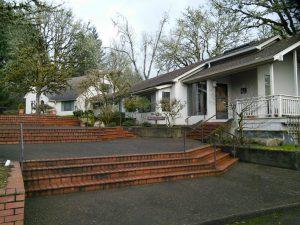
Guests on personal retreats are welcomed at the Trappist Abbey Lodge.
So if you’re looking for more than that Starbucks Escape, what’s on your list of retreat essentials? Contemplation and reflection requires a certain amount of time, quiet, and minimal distractions. Access to nature is a definite plus. Unplugging – doing without everything from the Internet to cell phones to TVs – is also very conducive to the work of soul searching.
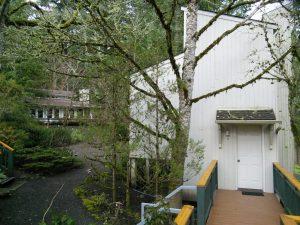
Individual guest houses at the Abbey are nestled among trees and walkways.
One spot that has proved ideal for me – that meets all of the above qualifications AND is easy on the pocketbook – is Our Lady of Guadalupe Trappist Abbey in Carlton. The monks at the Abbey are members of the Order of Cistercians and follow the “Rule of St. Benedict” which, in part, reads: “Let all guests who arrive be received like Christ.” (It should be noted that the majority of Christian monasteries around the world also follow these guidelines that were put into practice over 1500 years ago.)
Your hosts at the Abbey do, indeed, treat guests with great kindness, care, and respect.
For a recommended $50 per night donation, you can stay in the Abbey’s guest house accommodations, sharing a bathroom with one other visitor. You’ll be provided with all of your meals – simple but nutritious and tasty – and I’ve gotta say here that this is a very nice perk for a retreat. Your “job” while on a retreat is to spend time focusing on your inner life, your spirit, your hopes and dreams. The fewer distractions – like what to fix for dinner, washing dishes, binge-watching Netflix movies, etc. – the better.
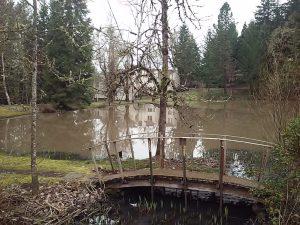
Walking paths, ponds, and acres of trees make nature an important part of your retreat at the Abbey.
The icing on the cake: The Abbey is less than an hour’s drive from Portland. But it’s a world away. Perfect for a retreat.
The guest house and services at the Abbey are, in fact, custom-made for personal retreats. As Kate, an Abbey volunteer, explained to me “the Abbey is meant to be a quiet, peaceful place for you to rest, relax, and reflect.”
An important note: While the monks who live, work, and worship at the Abbey are Catholic, retreatants can be of any – or no – particular faith. “That doesn’t matter here,” explains Kate. “Here you make your own personal retreat.”
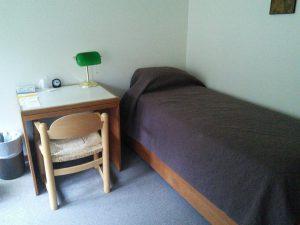
Rooms at the Abbey are clean and modest – exactly what’s needed to concentrate on your retreat.
That’s precisely what I did on my recent stay at the Abbey. I found just what I needed: quiet, nature, serenity, and TIME. I settled into my sweet, spare room – with a view of the forest – and, after some deep breathing, I was ready to plunge in. I found the meals to be perfectly timed diversions from my introspection. There are trails to wander, a small pond to sit by, books to borrow, and TIME and SPACE – for reading, writing, thinking, dreaming.
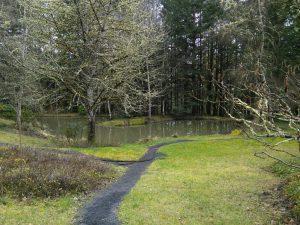
The view from my window is idyllic – and ideal for a retreat.
And there is ZERO pressure put on the retreatants by the folks at the Abbey, although spiritual direction (from one of the monks) can be arranged upon request. You can do exactly as you wish – as long as you respect the few, important rules of respect for the other guests and quiet.
How to “Retreat”
As noted, there are no true rules on how to conduct a retreat. It’s a personal thing so do what makes sense for you.
There’s plenty of help on the internet, but – big ASTERISK here – there’s no wi-fi at the Abbey. So if you want to access any of that World Wide Web wisdom, you’ll need to print it off ahead of time.
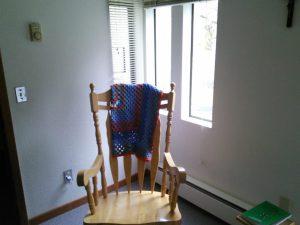
My room’s cozy rocking (and reading!) chair.
I bring books (see suggestions below), really comfy clothes, and my journal. A journal is, indeed, essential for most retreatants. Before you head out to your unplugged retreat location, google “benefits of journaling” – they are real and they are life enhancing.
Some people on retreat simply sit and write, extemporaneously. If you prefer some structure to your journal entries, you can ask yourself some basic questions to get started (sorta like prompts for writers):
What matters most to you? What do you hold sacred?
When do you feel most at peace?
What makes you happy? What activities give you the greatest joy, the most fulfillment?
Is it possible to live a life of no – or few – regrets? What would that look like? How would you spend your time? How would your life be different?
What do you think our purpose is here on earth? As author/environmentalist Wendell Berry asks in one of his essays, “What are people for?”
For me the ultimate query is: What are my values – and is my life in sync with them? The retreats I’ve taken help me to see where I’m doing okay with this Big Question – and where I could use improvement.
What do you “get” from your retreat? As they say, results may vary. For me a successful retreat means I’ve discerned for myself a greater sense of my purpose in life. And that typically comes with renewed energy to go back into the world and live a more intentional, authentic existence.
The 411:
For more information on the Trappist Abbey Guest House, visit this page. And please note: For those who can’t get away for more than a day, the Abbey offers small rooms for day use. They ask only $20 – and they’ll provide your meals too.
Books
The following is a small sampling of the many, many books that might be of help to you as you make your retreat:
The Woman’s Retreat Book: A Guide to Restoring, Rediscovering, and Reawakening Your True Self by Jennifer Louden (HarperOne, 2005)
Traveling Mercies: Some Thoughts on Faith by Anne Lamott (Anchor Books, 2000)
Transitions: Making Sense of Life’s Changes by William Bridges (Da Capo Press, 2004)
Man’s Search for Meaning by Viktor E. Frankl (Simon & Schuster, 1963)
When All You’ve Ever Wanted Isn’t Enough: The Search for a Life that Matters by Harold Kushner (Simon & Schuster, 1986)
Finding Your Way Home: A Soul Survival Kit by Melody Beattie (Harper Collins, 1998)
The Gifts of Imperfection: Your Guide to a Wholehearted Life by Brene Brown (Hazelden, 2010)
Marie Sherlock is an award-winning, Portland-based travel writer. Follow her on twitter @SherlockTravels.

